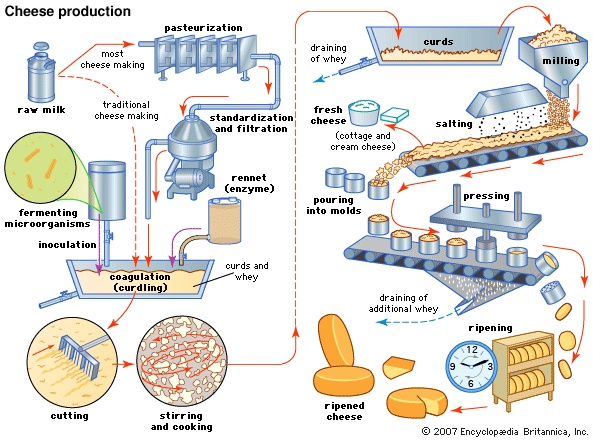cheese
food
 nutritious food consisting primarily of the curd, the semisolid substance formed when milk curdles, or coagulates. Curdling occurs naturally if milk is not used promptly: it sours, forming an acid curd, which releases whey, a watery fluid containing the soluble constituents; and it leaves semisolid curd, or fresh cheese. In some areas, cheese is still made simply by allowing milk to curdle naturally, or by mixing milk with juices or extracts that reduce it to curds and whey. A brief treatment of cheese follows. For full treatment, see dairy product: Cheese (dairy product).
nutritious food consisting primarily of the curd, the semisolid substance formed when milk curdles, or coagulates. Curdling occurs naturally if milk is not used promptly: it sours, forming an acid curd, which releases whey, a watery fluid containing the soluble constituents; and it leaves semisolid curd, or fresh cheese. In some areas, cheese is still made simply by allowing milk to curdle naturally, or by mixing milk with juices or extracts that reduce it to curds and whey. A brief treatment of cheese follows. For full treatment, see dairy product: Cheese (dairy product).Cheese making probably originated soon after humans first took milk from wild or domesticated animals. The Christian Bible refers to “cheese of the herd” being given to King David; milk from cows, and presumably from other animals, was used for cheese making by about 1000 BC. The ancient Greeks and Romans knew and valued cheese, as did early people in northern Europe. Methods for cheese making have often been kept secret.
 Important as a preservation technique, cheese making reduces about 10 volumes of milk to one volume of cheese. The curd, or soft gel, is formed by the chief protein in milk, casein, when enough lactic acid is developed from lactose (milk sugar) by the microorganisms present in the milk or when it is acted upon by rennin. Rennin is an enzyme usually obtained from the stomach of young calves in a brine extract called rennet. At the moment of coagulation, all the milk constituents, including most of the fat, casein, and other water-insoluble substances, are contained in the curd. The curd is cut or broken to release the whey, but a portion of the whey is always retained in the curd.
Important as a preservation technique, cheese making reduces about 10 volumes of milk to one volume of cheese. The curd, or soft gel, is formed by the chief protein in milk, casein, when enough lactic acid is developed from lactose (milk sugar) by the microorganisms present in the milk or when it is acted upon by rennin. Rennin is an enzyme usually obtained from the stomach of young calves in a brine extract called rennet. At the moment of coagulation, all the milk constituents, including most of the fat, casein, and other water-insoluble substances, are contained in the curd. The curd is cut or broken to release the whey, but a portion of the whey is always retained in the curd.Hundreds of varieties of cheese are made from the milk of cows, goats, sheep, water buffalo, horses, llamas, and yaks. Products vary according to the selection and treatment of the milk; adjustment of its fat content; heating or pasteurizing; and addition of enzymes or cultures of bacteria, molds, or yeasts. Curd formation varies with changes in temperature, time, acidity for coagulation, proportions of rennet and acid, and the speed and extent of removal of the whey. Ripening and curing consists of biological and chemical changes that occur in the cheese and are affected by the moisture content, acidity, texture, shape, size, and microorganisms in the cheese. These changes alter the consistency as well as the flavour of the cheese. Before ripening, cheese is said to be fresh or green; after ripening it is called cured, aged, or ripened. The chemical changes may be classified broadly as the breakdown of fats to fatty acids; proteins to amino acids; and lactose to such products as lactic, acetic, and propionic acids, diacetyl, and carbon dioxide. Flavourful products of ripening include volatile fatty acids, ketones, esters, alcohols, peptides, amino acids, ammonia, and hydrogen sulfide.
In modern factories, cheese is mass produced according to standardized recipes and techniques that result in a more uniform product. It is not necessarily of higher quality, and there are fewer varieties. Cheese making has been of primary economic importance for hundreds of years in The Netherlands, France, Italy, and Switzerland. Certain cheeses are historically associated with particular areas. Keeping quality is enhanced by a variety of procedures, including heating and kneading (Italian provolone) and soaking in brine (Egyptian Domiati). The loosely knit structure of French Roquefort develops blue mold only in a cool, wet atmosphere such as occurs naturally in the caves of Roquefort.
- Liutprand
- Liutprand of Cremona
- Liu Xiang
- Liu Yuan
- Liuzhou
- Liu Zongyuan
- live-bearer
- Lively, Penelope
- live oak
- liver
- liver cancer
- liver fluke
- liver function test
- Livermore
- Livermore, Mary Ashton Rice
- Liverpool
- Liverpool, Charles Jenkinson, 1st Earl of, Baron Hawkesbury Of Hawkesbury
- Liverpool delft
- Liverpool, Nicholas
- Liverpool porcelain
- Liverpool, Robert Banks Jenkinson, 2nd Earl of, Baron Hawkesbury Of Hawkesbury
- Liverpool Street Station
- liverwort
- livery company
- Livesay, Dorothy